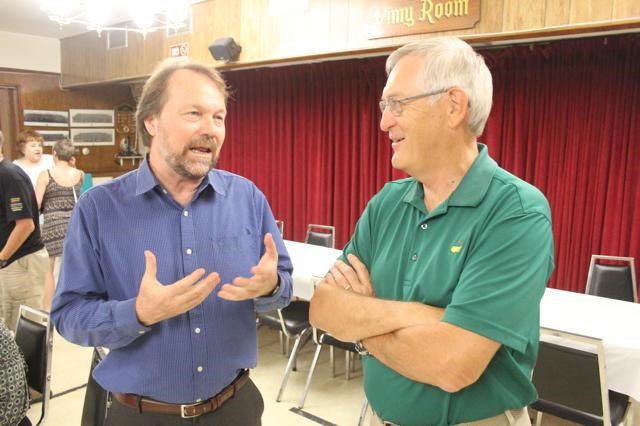By Greg Nikkel
The war-torn regions of Afghanistan and Sudan are a long way from Saskatchewan where Jeff McMurdo grew up, but for the past three years, his focus has been working with the United Nations Mine Action Service (UNMAS), clearing land mines and other anti-personnel and explosive devices left after war.
McMurdo gave an overview of the UN agency’s work to the Rotary Club in Weyburn on Thursday, as he was in Weyburn visiting family along with his daughter Adele, who has just graduated from the London School of Economics.
Hosted by his cousin Duane and Laurie Schultz, McMurdo noted he has several family members in Weyburn, including Duane’s mother, his aunt Rose Schultz, his other aunt, Lydia Hewitt and her daughter Diane Hewitt, and his brother Barry McMurdo and his wife Linda.
With the United Nations since 2009, McMurdo has worked for the last three years as program manager for UNMAS in Afghanistan and since last October in Darfur, Sudan, as they work to remove all land mines and explosive remnants of war (ERW).
“The work we do is very foreign to life here in Canada,” he said, noting UNMAS was created 20 years ago after the signing of the Ottawa Treaty, so named as Canada led the campaign for the elimination of land mines.
After years of armed conflict in Afghanistan, many fields throughout the country were riddled with land mines, as well as with unexploded ordinances and other ERW, and a humanitarian demining program was put in place to clear all of these explosive devices. This program was the first one of its kind in the world, and today is held up as a model for other countries.
So far, the program has cleared 2,125 square kilometres or 35 times the area of Manhattan, including 3,138 firing ranges, and the removal of 744,741 land mines, and 18.2 million items of ERW, clearing explosive hazards from 2,817 communities. The target is to have Afghanistan completely mine-free by the year 2023.
The agency estimates about 78 per cent of the country has been cleared, but with ongoing conflicts, there have been more hazards appearing, in particular improvised explosive devices (IEDs), which can be hidden on roadsides and can be very deadly.
Once an area is cleared of any military forces, the UNMAS team is the first to go in to clean it up, with a team that enters to do a survey with dogs and detectors.
“In the past, it was the military who cleared mines,” McMurdo noted, pointing out that the Afghans developed a very high quality program for mine-clearing, and those residents who are part of the teams that go in to find and destroy the mines are considered heroes by the Afghan people.
“It’s quite dangerous work,” said McMurdo, noting in Afghanistan the dangers not only came from the explosive devices, but from the Taliban, who have attacked the teams on occasion. “It’s often children who get hurt or killed.”
“In the past, land mines were the most deadly. Now by far it’s IEDs. These are very difficult to combat,” he added, noting these deadly explosives are often camouflaged and are intended to be anti-tank devices by the side of the road.
“It takes a lot of money to do this work. The end of a war is not with a peace agreement. The consequences do not end until you go in and clear all of the land mines and ERW,” said McMurdo.
Since moving to Sudan to run the agency out of Darfur, the work is a little different as land mines are not the hazard, but explosive remnants of war, such as unexploded grenades and bombs.
In 2016-17, the agency cleared 269 hazard areas in 190 villages, with 5,455 ERWs cleared and 183,000 residents were given risk education training.
McMurdo said he’s enjoyed coming back to Canada for visits since he’s been out of the country a lot since 1987, but admitted to his cousin, “I increasingly fail to recognize the Canada I once knew, but here at the Rotary meeting I found it. I think the work you’re doing is important, and I wish you much success in it.”
McMurdo noted he will be retiring in a few years, and will be taking up residence in his home in the Gatineau Hills near Ottawa, with a promise to visit often back in Saskatchewan.



